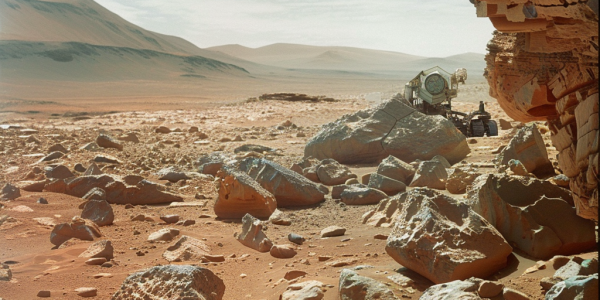NASA’s Curiosity Rover Uncovers Evidence of Ancient Lake on Mars
NASA’s Curiosity rover explores Mars’ Gale Crater, discovering high concentrations of Manganese in rocks that may have formed in an ancient lake. Recent findings suggest a link to biological processes, raising questions about the planet’s history. Ongoing research aims to unravel Mars’ geological mysteries.
Symphony of Planet 9: A Musical Ode to the Mysterious Celestial Body
Experience the captivating symphony inspired by the mysterious Planet 9, composed by Miami Symphony conductor Eduardo Marturet and performed by the Caltech orchestra. Delve into the gravitational dynamics of our solar system through this musical masterpiece, a collaboration between Marturet and Planet 9 researcher Konstantin Batygin. Recent breakthroughs reignite hope for discovering Planet 9, supported by compelling evidence presented in a new paper by Batygin, Brown, Morbidelli, and Nesvorny. Explore the avant-garde narrative of Planet 9 taking on a life of its own, as the symphony delves into the intellectual pursuit behind the hypothesis.
Massive Solar Storm Triggers Stunning Northern Lights Display Across US
A massive solar storm triggered ‘extreme’ levels of geomagnetic activity, leading to the Northern Lights being visible as far south as Florida. Aurora enthusiasts witnessed vibrant hues not seen in years, with the Space Weather Prediction Center reporting an ‘extreme’ event. While the mesmerizing auroras captivate onlookers, the broader implications of solar storms highlight the vulnerability of modern technology to space weather phenomena.
Understanding the Sun’s 11-Year Magnetic Pole Flip Cycle
Learn about the 11-year solar cycle and how the Sun’s magnetic pole flip leads to increased solar activity such as sunspots and solar flares. Discover the history of this cycle dating back to 1843 and its impact on phenomena like northern and southern lights.
Study Predicts Earth’s Future to be Uninhabitable for Mammals in 250 Million Years
A recent study published in Nature Geoscience predicts the eventual demise of mammalian life on Earth in 250 million years. Earth’s tectonic plates are projected to merge, releasing high levels of CO2 and raising temperatures to 40-50 degrees Celsius, making it impossible for terrestrial life to survive. This underscores the fragility of our planet’s ecosystem and the challenges future generations may face.
Geomagnetic Storm to Create Stunning Aurora Lights Across the U.S.
Exciting news for skywatchers in the United States as a geomagnetic storm is set to create stunning aurora lights across the country. The NOAA’s Space Weather Prediction Center has reported powerful solar flares from region 3663 of the Sun, potentially leading to spectacular Northern Lights displays in the northern U.S. Keep an eye out for the mesmerizing auroras and enjoy the beauty of nature’s light show!
Next-Generation Satellites Revolutionizing Earth’s Environmental Understanding
Learn how the National Oceanic and Atmospheric Administration (NOAA) is revolutionizing environmental monitoring with the upcoming launch of the Geostationary Extended Observations (GeoXO) satellite system. Discover how advancements in satellite technology are providing crucial data on climate changes, coral bleaching events, and ecosystem stressors, helping scientists gain a comprehensive understanding of Earth’s dynamic environment.
Impending ‘Triple Whammy’ Extinction Event Predicted to Wipe Out All Life on Earth
A ‘triple whammy’ extinction event is predicted to eventually wipe out all life on Earth, comparing to the most recent mass extinction event. Dr. Alexander Farnsworth from the University of Bristol forecasts extreme heat, aridity, and uninhabitability in Earth’s future, leading to widespread extinction. However, this cataclysmic event is estimated to occur in approximately 250 million years, sparing current generations from its dire consequences, unless accelerated by human-induced climate change.
The Science of Siblings: Exploring the Planetary Relationship Between Earth, Mars, and Venus
Explore the fascinating science of siblings and their impact on our lives, from finances to mental well-being. Discover the similarities and differences between Earth and its sibling planets, Mars and Venus, and how they have evolved over billions of years. Venus, once potentially habitable, now presents extreme conditions that make it a challenging environment for exploration, shedding light on the delicate balance that sustains life on Earth.
Remains of ‘Buried Planet’ Uncovered Deep Within Earth, Potentially Linked to Moon-Forming Impact
Scientists have made a fascinating discovery deep within the Earth, uncovering the remains of a ‘buried planet’ possibly linked to a moon-forming impact 4.5 billion years ago. Seismologists identified massive ‘basal mantle anomalies’ beneath the Pacific and Africa, suggesting a unique material composition. Researchers speculate these anomalies could be remnants of a planet named Theia, offering insights into Earth’s collision history and moon formation. The discovery opens new avenues for understanding celestial collisions and planetary dynamics.










